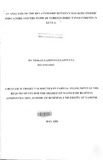| dc.description.abstract | The research sought to look at specific macro economic determinants that
affect the Foreign Direct Investment (FDI) inflow to Kenya. The logic being
that each country is structurally diverse and that there are substantial
discrepancies in the basic macroeconomic variables that characterize an
economy. The study therefore sought to determine the critical
macroeconomic indicators and their relationship to the flow of FDIs to
Kenya and to develop a regression model to predict the level of FDI based
on the identified macroeconomic indicators.
The study w as restricted t 0 the Kenyan economy between the years 1990
and 2005, the period being judgmentally selected as it is more relevant to the
current situation. Due to the fact that the FDI inflow depends on a number of
macroeconomic determinants, multiple linear regression was used to
determine the important variables that influence FDI inflow to kenya.
Research findings from the Data Analysis indicate that the mam
macroeconomic indicators that affect FDI inflow to Kenya include inflation,
NSE Index, Annual GDP growth rate, total external debt, total exports, tax
on International transactions and total imports. High Inflation and taxes on
international transactions continuously created negative distortions to the
Kenyan economy reducing FDI Investors. On the other hand, increased
volumes of trade (import and export) have positively signaled to openness of
trade and therefore more FDIs to Kenya. Similarly the findings reflect that
higher external debt is positively related to FDI inflow to Kenya since
increased multilateral donor funding to the Kenyan government helps to
boost investor confidence hence higher FbI inflows through Multinational
Enterprises.
Contrary to the previous literature, the FDI inflow to Kenya has been
negative to GDP growth. This is explained by the fact that the Kenyan
government has tended to dispose its stake in parastatals to foreign investors
in periods when the economic growth is low in order to get more funding to
bridge the budgetary gap hence increased FDIs. The findings further reveal
that high NSE Index levels negatively relate to the FDI inflow to Kenya.
The findings opens the way for further research on the impact of FDI
inflows to reduction of poverty levels in Kenya as well as the impact of FDI
inflows to the stock market in Kenya. | en |

